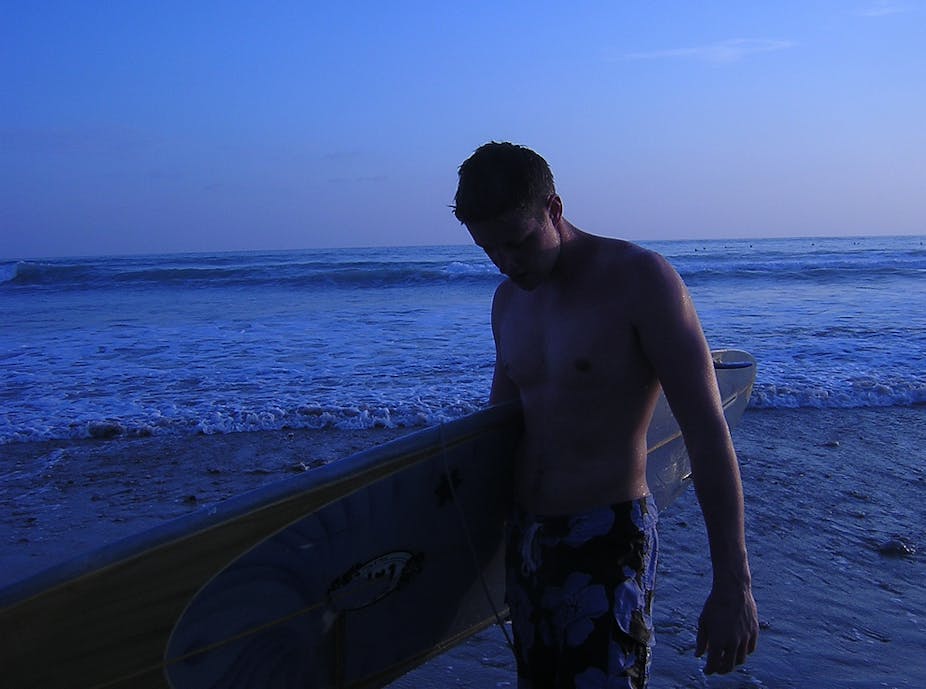Last October surfboard company BASE abruptly closed its factory on the Gold Coast, with the direct loss of 30 jobs. Since then, nearby D’Arcy Surfboards has announced it is shedding workers and downsizing from a state-of-the art, purpose-built factory into a backyard workshop. Is the surfboard industry yet another victim of the high Australian dollar?
Dominating conversation on the future of Australian manufacturing has been talk of exports and the high dollar. Australia cannot compete in a race to the bottom for cheap labour. Even if the dollar drops substantially, the more complicated truth is that there are deeper structural and human issues threatening the making of things in Australia.
Surfboards: an Australian niche
Led by UOW economic geographer Andrew Warren, we have been undertaking research on the Australian surfboard industry for the past three years.
Few realise that surfboards are still made by hand: by expert “shapers” who plane and sand foam “blanks”, and “glassers” who seal them against the elements. Because they are customised to local waves and body size, most Australian surfers ride boards made locally - even when cheaper imported boards are available.
Australia has had an advantage in surfboard-making since the 1960s, when Bob McTavish invented the “plastic fantastic” board, sparking the so-called shortboard revolution. Simon Anderson’s 1980 “Thruster” design, now the industry standard, was also an Australian innovation. Since then hundreds of surfboard workshops have sprouted, up and down the coast, where there are good waves: Noosa, the Gold Coast, Byron Bay, Port Macquarie, Newcastle, Brookvale, Cronulla, Wollongong, Torquay.
In the 1980s and 1990s the industry grew on the back of surfing’s sexy, tanned, outdoors appeal. Quiksilver, Billabong and Rip Curl, from Torquay, branched out into fashion and apparel. They have since suffered from the global economic slowdown, with piles of unsold inventory in American and European flagship stores.

Making by hand or by machine?
Smaller local workshops face different pressures. First, machines have replaced human craftsmanship. Only recently has it become possible to shape boards more cheaply using computer-aided design and machine-cutting technology. Workshops have embraced machines. Trying to compete with corporate surf brands for retail exposure, they used loans to finance costly machinery, fattened marketing budgets and increased volume.
The result has been increased sales in good times, but also greater risks when the economy contracts.
Retail wars
Second, power has concentrated with retailers. When the first workshops opened in the 1960s there were few surf shops. Now it is very competitive. Workshops without boards in retail megastores miss out on the lucrative market for beginners.
Risky handshake deals have been made with surf retailers to stock boards – often on consignment, and with lengthy delays on getting paid. It worked – only just – when the market grew. But since the global financial crisis and the slump in domestic tourism, declining retail sales have combined with unpaid bills and slim margins to increase risk of bankruptcy.
Mates growing old
Third, this is a remarkably informal industry: it all started when a bunch of mates who made boards for each other took their craft seriously enough to register businesses and open up commercial workshops. To this day, the business-customer relationship is typically that of mates who surf the same waves together.

It also means the “industry” is poorly organised, lacks lobbying power, and pays shapers and glassers casually. Employees are “mates”, there are no unions, and as the market contracts, workshops have cut costs by shedding staff or cutting casual hours.
There are also no recognised qualifications for shaping, other than the informal rule that “master-shapers” must have carved out at least 30,000 boards. The issue is now critical because the original generation of Australian surfboard-makers is growing old, and with rare exception has failed to train up newcomers. Some workshops are too small; others have been fearful of having their niche poached by young upstarts.
The very real possibility is that when ageing shapers retire there won’t be a younger generation to replace them. Surfboard-making could become purely mechanised. Then Australia would be forced to compete with Thailand and China for cheap “pop-out” boards.
RIP Australian surfboard-making?
Is the death of Australian surfboard-making inevitable? Perhaps not. Surf culture provides the industry its core base: regular local surfers damage their boards every year or so, and when buying new ones remain loyal to their preferred shapers.

The more likely scenario is that of the D'Arcy workshop on the Gold Coast: scaling back to cottage industry size. That would be a shame. Surfboard-making is worth maintaining, for its high quality products, its competitive advantages in Australia, and its deep links to a coastal way of life.
Beyond the high dollar, closer mapping of the challenges and opportunities of small-scale manufacturing is critical, before decision-makers jump to conclusions. Let’s not forsake the making of things for which Australian regions and workers have distinct talents.

